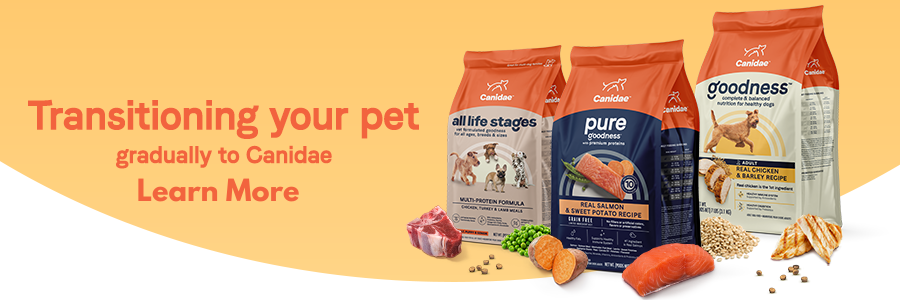The Benefits of Limited Ingredient Dog Food
As a dog owner looking for the best food to feed your dog to keep him in great shape, you may have come across pet food labels or articles referring to a limited ingredient dog food diet.
Opting for food with fewer ingredients has become increasingly popular among pet parents in recent years. So, what does this mean and when could this be a good option for your canine companion?
What is limited ingredient dog food?
Dogs are omnivores and eat a variety of food including protein, fruit and vegetables. Meat is a great source of protein for dogs and most dog foods will contain meat as one of the main ingredients, as well as a combination of other ingredients listed on the tin or packaging.
The first thing to note is that there is no official definition for limited ingredient dog food − specifically for the number of ingredients a product should contain to qualify as being a limited ingredient product.
In other words, what constitutes a limited ingredient product is open to interpretation.
What we can say, though, is that generally, this type of pet food contains fewer ingredients than the standard dog food – particularly referring to the number of proteins, and in some cases, the number of carbohydrates.
When should I consider a limited ingredient dog food diet for my dog?
Traditionally, a limited ingredient diet is one of the ways to diagnose and manage allergies and food intolerances in dogs.
Like us, our pets can suffer from allergies, although we should add that overall the percentage of dogs with food allergies is relatively low. Some common culprits of food allergies in dogs include chicken, red meat, dairy, eggs and wheat.
So, if your dog shows symptoms of allergy, such as itchy skin or digestive issues, he or she may benefit from a limited ingredient diet.
What is a food allergy?
Food allergies occur when a dog’s immune system mistakenly assumes the food it has eaten is harmful and tries to defend the body by triggering an allergic reaction. This manifests itself in symptoms affecting the skin and/or digestive tract, such as itchy skin, weight loss, vomiting or diarrhea. Our previous post has more information about how to spot if your dog has an allergy.
Food intolerance is a little different from food allergies in that it usually is limited to digestive system problems. An inability to digest a certain ingredient can cause an upset stomach, vomiting or diarrhea.
Identifying the exact ingredient that triggered a food allergy or intolerance is not always easy and takes time. There are no reliable diagnostic tests for food allergies and therefore your vet may recommend a hypoallergenic diet, also known as a food elimination diet, for 8 to 12 weeks to try to identify the culprit.
This is where a limited ingredient diet comes in – as it is one type of diet used by vets to aid in diagnosis of allergies.
How does a limited ingredient diet work?
Diagnosing allergies
A limited ingredient diet is made up of a limited number of carefully selected ingredients so it’s easier for you or your vet to pinpoint exactly which ingredient is the cause of your dog’s allergic reaction.
A limited ingredient diet can also be a novel protein diet – which means a diet that contains only one protein source which your dog has never tried before – i.e. a novel protein source – and often only one or two types of carbohydrates. Your dog will usually not be allergic to this new protein as allergies in dogs develop over time.
So, your vet will want to see if your dog’s symptoms go away after following a novel protein diet for some time. Then, to be sure that the original questioned ingredient was the cause of the problems, the suspected culprit ingredient will need to be reintroduced to check whether your dog’s symptoms reoccur.
By gradually adding pure protein sources to the trial diet and observing your pet’s reactions, it is possible to confirm or dismiss a food allergy.
Preventing and managing allergies
Once a food allergy is confirmed, you can either choose to stick to the limited ingredient diet for your pet or, in consultation with your vet, investigate other suitable dietary options.
A limited ingredient diet can also help with allergies and prevent them as it makes sense that the fewer ingredients a product contains, the less chances there are of your pet being allergic to something in the food.
Some dogs may have food sensitivities. They may tolerate certain ingredients better than others and keeping the number down to a few simple ingredients will make it easier to know what exactly your dog is eating.
Sometimes a limited ingredient diet is referred to as “clean eating” for dogs by pet parents who want to extend this lifestyle to the canine members of their family.
Although this type of diet contains fewer ingredients than standard types of dog food, limited ingredient food products still provide all of the necessary nutrients your dog needs. Remember to always consult with your veterinarian if you’re unsure about what product is the best limited ingredient dog food for your pet.
What's the difference between limited ingredient dog food and grain-free?
It’s important to note that a product labeled as containing limited ingredients doesn’t necessarily have to be grain-free. Carefully check the list of ingredients to ensure a product doesn’t contain grain if you are looking for a grain-free diet for your pet.
Limited ingredient formulas
Canidae® PURE limited ingredient formulas offer your dog a well-rounded meal crafted with their health and well-being in mind. Each recipe contains a limited number of wholesome ingredients that are easy to recognize.
Our PURE dog food range contains a few simple ingredients to support dogs with sensitive stomachs. Each bite offers a natural balance packed with premium ingredients. Our products are filler-free, with no artificial flavors, colors or artificial preservatives.
Discuss transitioning your dog to Canidae’s delicious recipes today!


